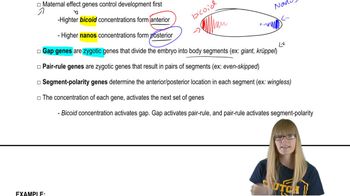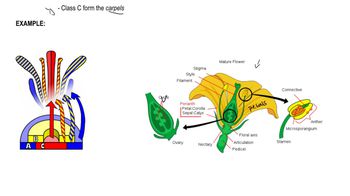Table of contents
- 1. Introduction to Genetics51m
- 2. Mendel's Laws of Inheritance3h 37m
- 3. Extensions to Mendelian Inheritance2h 41m
- 4. Genetic Mapping and Linkage2h 28m
- 5. Genetics of Bacteria and Viruses1h 21m
- 6. Chromosomal Variation1h 48m
- 7. DNA and Chromosome Structure56m
- 8. DNA Replication1h 10m
- 9. Mitosis and Meiosis1h 34m
- 10. Transcription1h 0m
- 11. Translation58m
- 12. Gene Regulation in Prokaryotes1h 19m
- 13. Gene Regulation in Eukaryotes44m
- 14. Genetic Control of Development44m
- 15. Genomes and Genomics1h 50m
- 16. Transposable Elements47m
- 17. Mutation, Repair, and Recombination1h 6m
- 18. Molecular Genetic Tools19m
- 19. Cancer Genetics29m
- 20. Quantitative Genetics1h 26m
- 21. Population Genetics50m
- 22. Evolutionary Genetics29m
14. Genetic Control of Development
Developmental Patterning Genes
Problem 17a
Textbook Question
In contrast to Drosophila, some insects (e.g., centipedes) have legs on almost every segment posterior to the head. Based on your knowledge of Drosophila, propose a genetic explanation for this phenotype, and describe the expected expression patterns of genes of the Antennapedia and bithorax complexes.
 Verified step by step guidance
Verified step by step guidance1
<Step 1: Understand the role of Hox genes in segment identity. Hox genes are responsible for determining the identity of body segments in animals. In Drosophila, the Antennapedia and bithorax complexes are clusters of Hox genes that specify the identity of segments in the thorax and abdomen.>
<Step 2: Compare the expression of Hox genes in Drosophila and centipedes. In Drosophila, the Antennapedia complex is responsible for specifying the identity of the thoracic segments, while the bithorax complex specifies the identity of the abdominal segments. In centipedes, the expression of these genes might be different, leading to the development of legs on almost every segment.>
<Step 3: Propose a genetic explanation for the phenotype in centipedes. One possibility is that the Hox genes in centipedes have a broader or altered expression pattern compared to Drosophila, allowing for the development of legs on more segments. This could be due to changes in the regulatory regions of these genes, leading to differences in their spatial and temporal expression.>
<Step 4: Describe the expected expression patterns of the Antennapedia complex in centipedes. In centipedes, the Antennapedia complex might be expressed in a larger number of segments, including those that would normally be legless in Drosophila, resulting in the development of legs on these segments.>
<Step 5: Describe the expected expression patterns of the bithorax complex in centipedes. The bithorax complex might also have an altered expression pattern, potentially allowing for the development of legs on segments that are typically abdominal in Drosophila. This could result in a more uniform distribution of legs along the body.>
Recommended similar problem, with video answer:
 Verified Solution
Verified SolutionThis video solution was recommended by our tutors as helpful for the problem above
Video duration:
3mPlay a video:
Was this helpful?
Key Concepts
Here are the essential concepts you must grasp in order to answer the question correctly.
Homeotic Genes
Homeotic genes are crucial in determining the identity of body segments during development. In Drosophila, these genes, such as those in the Antennapedia and bithorax complexes, dictate the formation of specific structures in each segment. Mutations in these genes can lead to the transformation of one body part into another, illustrating their role in segment identity.
Recommended video:
Guided course

Segmentation Genes
Antennapedia Complex
The Antennapedia complex is a group of homeotic genes in Drosophila that primarily regulates the development of the thoracic segments. When expressed, these genes promote the formation of legs in the appropriate segments. Misexpression or mutations can result in legs developing in place of antennae, highlighting the complex's role in segmental identity and limb formation.
Recommended video:
Guided course

Segmentation Genes
Bithorax Complex
The bithorax complex consists of homeotic genes that control the development of the posterior segments in Drosophila, particularly the abdomen and the second thoracic segment. This complex is responsible for specifying the identity of these segments, and alterations in its expression can lead to transformations, such as the development of additional wings or altered segment structures, which can help explain variations in limb development across different insect species.
Recommended video:
Guided course

Segmentation Genes

 11:19m
11:19mWatch next
Master Segmentation Genes with a bite sized video explanation from Kylia Goodner
Start learningRelated Videos
Related Practice


